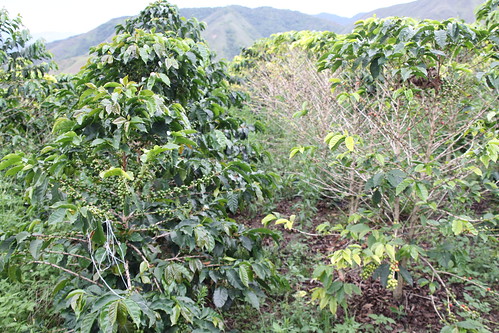Yesterday I spent the whole day at Coocentral in Garzon to cup coffees. Coocentral is the co-operative that Elias is working with and where he is delivering his coffee. They have been a big support of our project and are currently providing Elias with pre-financing of his coffee (they buy it from him for market price and keep it in the warehouse until they sell it to me) as well as agronomical assistance, logistics, and quality control of the dried coffee.
Although I am a very small customer to Coocentral, they have been very supportive of my work for 5 years and that is one of the biggest reasons why I am working in this area in Colombia. Emel, who people refer to as no 2 in the organization, says that they are very happy to support my project together with Elias as they see that other farmers are being motivated by what we do and are now trying to do a better job. There is nothing I want more that being able to contribute to better quality coffee and a better quality of living for Colombian coffee farmers.
So, to the point. We spent the whole day yesterday, sample roasting and cupping 31 samples of coffee, whereas 15 were from Finca Tamana and the rest were random samples from the regions of Suaza, Garzon, Guadalupe and Acevedo. We cupped the coffees blind of course and revealed the results after each cupping session. There were some controversial boarderline coffees on the table that were very close to being over fermented, but the general quality seemed to be higher than from my visit in June. A lot of coffees had good intensity with a lot of fruit character and citric acidity with a big juicy mouthfeel. My scores ranged from 80 points to 87 points. The lots from Finca Tamana performed better than expected. Elias has had difficulties with drying times for up to 50 days and I was very concerned the coffee would have off tastes because of the prolonged drying. To our big relief all coffees scored between 84 and 87 points and Elias had the 3 best lots of the day. To my surprise it was the 3 lots with the longest drying time. I am very eager to see how these coffees will hold up in the coming months.
The quality from Tamana seems to be higher than the harvest in June which I am very pleased with. As the Mitaka is a difficult harvest, with almost no coffee on the trees, Elias has been paying the pickers more to make sure they do an extra thorough job while picking. Because of the higher quality and higher expenses, I offered him a better price for his coffees for this harvest. We will also be putting a premium on top of the price of the coffee from June in order to be able to finance some infrastructure on the farm that will improve the quality for next harvest.
Another interesting thing worth mentioning is that we cupped several lots of the Castillo variety. We even cupped a Castillo vs a Caturra that came from the same farm, picked and processed under the same conditions. In this case I gave the Castillo 86 points and the Caturra 83 points(cupped blind.) We also had other Castillos scoring from 84 to 86 points. They seem to have a character with malic acidity and a lot of red fruits and apple / papaya flavours in this region (probably too early to make a conclusion of that.) A lot of people in the coffee industry seems to be very sceptic about new varieties, but when they are performing well in the cup and also are resistant to leaf rust so that the farmer can spray less chemicals in the field and still have a good production, I can only see positive things about the Castillo. Yes, there are Caturras that are scoring much higher, but the Castillo is very new and not a lot of farmers are cultivating it yet. I am certain we will see some really nice Castillos in the market in the future. If you are still a sceptic, then all I have to say is that the famous Kenyan SL 28 also was a new and “improved” variety made by Scott Laboratories in the past century.
(Castillo to the left, Caturra to the right. These trees were fertilized and sprayed a lot. Still the Caturra did not perform at all.)

